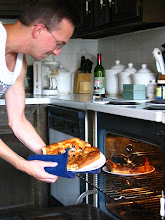Readers: a quick update: next week, I'll run the best of CK 2013. Look for it!
***********************************
It never crossed my mind that I could create my own recipes.
I used to think recipe development was something "experts" did. You know,
qualified people. As in cookbook writers. Chefs. Nutritionists. People with test kitchens and training in food science. Normal people are supposed to
follow recipes. We don't just...
make up our own. Right?
Well, wrong. I’m here to tell you that yes, we normal people
can make up our own recipes. And if I can do it, trust me: you can too.
Look, I’m no expert at recipe development. Not yet. So don't worry: I won’t unleash
my inner Tim Ferriss on you and pretend to have expertise I don't have. Consider what you’re about to read as the thoughts of an advanced beginner.
But as you’ll see, it’s a surprisingly small leap to go from simple improvisational cooking activities that any home cook does regularly to creating recipes that are unique--and all your own.
My first tentative (and accidental) steps
How did I get started creating recipes? More or less by mistake. At first, I was simply experimenting with recipes I already used, thinking about how I might make them better, easier, less time-consuming… and of course, less expensive. One of my first major recipes I tinkered with was
Chicken Mole, one of the most popular recipes in CK’s entire
recipe index.
My
mole recipe is very,
very distantly derived from a recipe I found in an ancient copy of Bon Appetit magazine. At first, I took that recipe and dramatically simplified it, stripping out steps and simmering time in order to make the recipe less time-consuming. Next, I started tweaking the spices, just for fun. I added cayenne pepper, increased the quantity of chocolate (
how could that be a mistake?) and made other changes, all with the intent of making the recipe better, easier, and more interesting.
And then, a terrible accident happened. One day, while I was making a batch, I (for whatever idiotic reason) stepped away from the kitchen during Step 2, where you heat the spice mixture in oil. For a few crucial minutes,
I forgot all about it. When I realized and sprinted back to the stove, the spices were blackened and burnt, and I was convinced the recipe was ruined.
And yet it
wasn’t ruined. I finished making the recipe anyway,
and it came out the best it ever tasted. Smoky, sweet and nuanced, like nothing I’d ever eaten before.
In other words, months of tinkering--combined with a moment of pure dumb luck--collectively added up to a change so drastic that my mole sauce wouldn’t even
recognize the recipe it descended from. This recipe had become mine.
Thus, in one sense, a helpful way to think about recipe development is to consider it nothing more than a significant act (or series of acts) of recipe modification. At some point you've changed up someone else’s recipe so much that, well, it becomes yours.
Becoming generative
My Mole Sauce experiment (mistake?) gave me confidence, and I started to make a habit of tweaking and adjusting other recipes too. Of course, not all my improvements and adaptations worked (some of them were clearly “unimprovements”), but I got better at it as I practiced.
Which took me to the next step: Instead of merely adapting or changing existing recipes, I tried to be more original and generative in my recipe development. I tried to come up with my own ingredient combinations from scratch, without the influence of an already-existing recipe.
I started asking myself things like
what ingredients haven't I seen combined that might go well together? What dishes might make use of these flavors?
For example: take a standard Middle-Eastern spice mix (say, cumin, coriander and cinnamon). Which types of meats (chicken? Beef? Pork?) would work well with this spice mix? Add, perhaps, lemon slivers and olives... and now you’re looking at something like
North African Lemon Chicken.
In fact, years ago
I created a tool for making new and original pasta salads that performed exactly this generative exercise. I called it the Pasta Salad Permutator. Back when I wrote that post, I didn't know quite what I was doing yet, but I was onto something. Essentially, I was asking:
which of these ingredient combinations might “work" together? Could they be the foundation of an original recipe? What else can I add? These are the basic, fundamental questions behind new recipe creation.
This is a skill that I'm sloooowly developing, and each time I try a new recipe idea I'm always surprised by the result. And not always positively! Often, ingredient combinations that seem good in theory just... aren't. Likewise, the flavors of a recipe don't always render in real life the way you expect them to in theory. That's why most new recipes require repeated adjustments and changes before they're ready for prime time. An example: I had to make three separate test batches of my
Garlic Sundried Tomato Soup--which I tried out on three different sets of very patient dinner guests--before I was confident enough to put the finished recipe in front of readers.
Of course, every once in a while the stars align and a recipe comes out perfectly on the first try (like my
Easy Chicken and Tomato Sauce for example), with no adjustments at all. Then again, some of my new recipes suck and need to be discarded. Fortunately, dear readers,
those recipes never make it to the blog.
What makes a recipe yours? Musings on intellectual property
A final word on intellectual property with recipes. What makes a recipe "yours" compared to "somebody else's"?
Honestly, I'm not 100% certain. But let’s start with a few things that
are certain. There are, for example, specific copyright rules for recipes. For example, a list of ingredients isn't copyrightable. This might come as a surprise to many readers.
However, process steps and written instructions
are copyrightable. And obviously, photographs, musings, text and articles that accompany a recipe are
clearly copyrightable property. As someone who’s had entire
posts stolen and copy-pasted onto other sites, I can say the following with total authority: If you steal these things, you're a plagiarist
and a thief. Uh, and a jerk.
Also, even if you've gone ahead and adapted a recipe beyond recognition, it's still excellent form to say where you got the recipe from. This is why, occasionally, you’ll see citations here in Casual Kitchen like:
Borrowed and modified without permission from our friend Karen
or:
Modified beyond recognition from an old issue of Bon Appetit Magazine
or even:
Modified, but not beyond recognition, from Taste of the Middle East by Soheila Kimberley
Those are my thoughts on the discipline of recipe development. Readers, what are yours? How have you gone about developing your own new recipes? Where do you get your ideas?
Related Posts:
Seven Ways to Jazz Up Your Morning Eggs
Applying the 80/20 Rule to Diet, Food and Cooking
Cooking Like the Stars? Don't Waste Your Money
How can I support Casual Kitchen?
Easy. Do all your shopping at Amazon.com via the links on this site! You can also link to me or subscribe to my RSS feed. Finally, consider sharing this article, or any other article you particularly enjoyed here, to Facebook, Twitter (follow me @danielckoontz!) or to bookmarking sites like reddit, digg or stumbleupon. I'm deeply grateful to my readers for their ongoing support.
via the links on this site! You can also link to me or subscribe to my RSS feed. Finally, consider sharing this article, or any other article you particularly enjoyed here, to Facebook, Twitter (follow me @danielckoontz!) or to bookmarking sites like reddit, digg or stumbleupon. I'm deeply grateful to my readers for their ongoing support.








